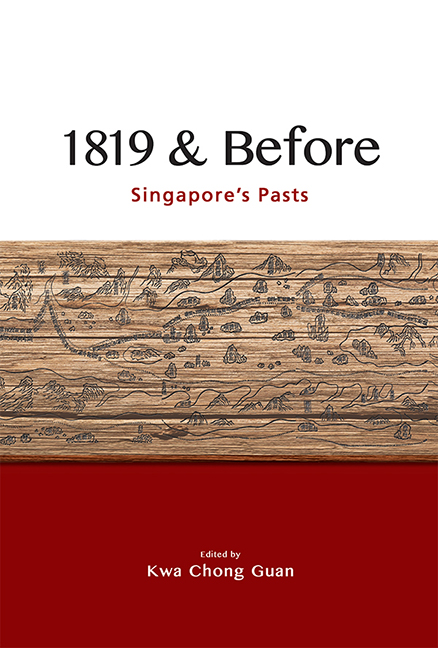Book contents
- Frontmatter
- Contents
- Foreword
- Acknowledgments
- Contributors
- 1 Introduction: Approaches to Singapore’s Past before 1819
- 2 Issues and Approaches to Studying Singapore before 1819
- 3 Regional Influences, International Geopolitics and Environmental Factors in the Rise and Demise of Temasek
- 4 The Mysterious Malay Jong and Other Temasek Shipping
- 5 The Orang Laut and the Negara Selat (Realm of the Straits)
- 6 Avoidance of Shipwreck in the Malay Annals: A Trope in Buddhist Narratives of Maritime Crossings
- 7 The Inception of Lion City
- 8 A Note on Amoghapāśa-Lokeśvara in Singapura
- 9 Portuguese and Dutch Records for Singapore before 1819: An Overview
- 10 Zheng He’s Navigation Methods and His Visit to Longyamen, Singapore
- Bibliography
- Index
Foreword
Published online by Cambridge University Press: 09 October 2021
- Frontmatter
- Contents
- Foreword
- Acknowledgments
- Contributors
- 1 Introduction: Approaches to Singapore’s Past before 1819
- 2 Issues and Approaches to Studying Singapore before 1819
- 3 Regional Influences, International Geopolitics and Environmental Factors in the Rise and Demise of Temasek
- 4 The Mysterious Malay Jong and Other Temasek Shipping
- 5 The Orang Laut and the Negara Selat (Realm of the Straits)
- 6 Avoidance of Shipwreck in the Malay Annals: A Trope in Buddhist Narratives of Maritime Crossings
- 7 The Inception of Lion City
- 8 A Note on Amoghapāśa-Lokeśvara in Singapura
- 9 Portuguese and Dutch Records for Singapore before 1819: An Overview
- 10 Zheng He’s Navigation Methods and His Visit to Longyamen, Singapore
- Bibliography
- Index
Summary
There is ample archaeological evidence today to argue that the island of Singapore was a trading port of significant importance from the fourteenth century, and perhaps earlier. This archaeological evidence has been accumulated over the decades from Singapore's very first archaeological dig in 1984 at Fort Canning Hill to the current work of the Archaeology Unit at the ISEAS – Yusof Ishak Institute. However, public interest in Singapore's pre-modern history is very much a recent phenomenon. For one, until recently historians paid very little attention to the island's pre-modern histories. As Kwa Chong Guan informs us in his first chapter in this volume, seminal texts like Mary Turnbull's A History of Singapore, 1819–1975 did little to try to understand Singapore as a pre-1819 regional port or see it as part of the larger Malay world. Kwa notes that this was because there was either insufficient evidence of pre-1819 communities for serious investigation or that these communities were not believed to be significant enough to justify studying. Much of the writing of national histories in Southeast Asia took colonialism as the starting point and embarked on a chronology that included post–World War II decolonization, the emergence of postcolonial governments and their struggles to build new nations during the Cold War. Pre-modern empires, sea-faring communities and border-crossing fishermen did not command the same attention as newly formed nation-states, authoritarian governments and developing economies.
The other reason for the lack of interest in Singapore's pre-modern histories was decidedly ideological. Upon expulsion from Malaysia in 1965, Singapore's multicultural society made it politically untenable for its national history to be hitched to the civilization and culture of any particular ethnic group. With multiculturalism and meritocracy as its pillars, it would have been contradictory to equate national identity and culture with the country's largest ethnic community. In cutting the Gordian knot, the postcolonial government decided that the arrival of Sir Stamford Raffles to establish a British Station on Singapore would be ground zero without appeal to any ethnic culture. For many generations of Singaporeans, Singapore was born as a modern entity, transformed from the proverbial quiet fishing village to a colonial entrepôt with the stroke of a pen on 6 February 1819. This popular version of history was a strategic rupture, effectively dislocating the island from its surroundings and region, to introduce the island as tabula rasa.
Fast forward fifty years and the external environment has changed. Today the rise of China has made regionalism and sub-regionalism in Southeast Asia more geopolitically crucial than ever before.
- Type
- Chapter
- Information
- 1819 & BeforeSingapore's Pasts, pp. vii - xPublisher: ISEAS–Yusof Ishak InstitutePrint publication year: 2021

